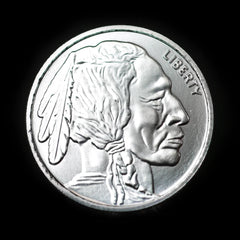People often ask me why I think it's important to invest in Gold & Silver. I always tell them the same thing – Gold & Silver cannot be printed like Dollars, Euros, Yen, Pounds, or any other currency that exists. If history has taught us anything, it's that a government with the ability to print its own money will abuse that power!
In 2008, Zimbabwe introduced the 100 Trillion Dollar banknote underlining their hyperinflation as one of the worst cases in World history. More on the worst cases of hyperinflation here:

In 2008, Zimbabwe introduced the 100 Trillion Dollar banknote underlining their hyperinflation as one of the worst cases in World history. More on the worst cases of hyperinflation here:
https://www.cnbc.com/2011/02/14/The-Worst-Hyperinflation-Situations-of-All-Time.html
Why Rarity & Scarcity Is An Important Reason To Own Gold & Silver
I became acutely aware of that lesson in November 2008 when the United States Federal Reserve created $600 billion out of thin air to buy bad debt, save bad banks, and rescue the global financial system. By January 2009, I had already purchased my first Gold Pamp Suisse bar & 10 American Silver Eagles. To this day when somebody asks me who got me into stacking precious metals, I tell them it was Ben Bernanke. Gold and silver have proven to be a reliable long term store of value, helping to preserve wealth over time.

Ben Bernanke – Chairman of the US Federal Reserve from 2006 to 2014. More on the 2007/2008 crisis & Fed response here: Financial Crisis Wiki
But Aren’t Gold & Silver Supplies Unlimited Like Dollars?
So, now that we’ve established that the supply of currency is theoretically infinite, why are Gold and Silver such good alternatives? Isn’t the supply of gold and silver infinite in that we can mine it forever? Not exactly…
Gold & silver have played the role of money for more than 2000 years! Empires have risen and fallen based on their ability to respect the integrity of the sacred metals-based money system. Why? Because of the limits it imposes on a government’s ability to devalue its debts, obligations, and the savings of its people. In fact, a clear trend we recognize by looking at historical empires is that the more they respect the gold & silver money system - the more they flourish (this is visible in Rome’s golden age and the USA’s rise as a superpower after the Spanish-American War in 1898).
So, although it is true that more gold & silver are mined each year, it is almost an insignificant amount compared to the total amount in existence. Global silver production from mining operations adds only a small percentage to the overall supply annually, as extracting silver from the earth is a complex and resource-intensive process. For example, in 2023, gold’s supply increased by approximately 1% according to the World Gold Council (based on newly mined supply - excluding recycled gold). When we compare that to the fact that 3 of every 43 American Dollars (M1 Money Supply) has been created since 2020 (+350% increase) - the limited nature of gold & silver vs. paper money becomes quite obvious! And because we have a good idea of how much gold and silver has been mined throughout history, we can distinguish between the total amount of mined silver and gold above ground and what still remains to be extracted. Scientific estimates suggest that only a fraction of the gold and silver present in the earth's crust has been recovered, with significant quantities still left. The supply is not infinite; large amounts of silver and gold remain in the ground, waiting to be extracted from mines around the world.

Roman Aureus – the golden coin of Ancient Rome. More on the history of metals as money here:
https://www.gold.org/history-gold/gold-as-currency
How Much Gold & Silver Is There?
As of 2024, about 25 billion troy ounces of Silver and 10 billion troy ounces of Gold have been mined—a huge number that highlights the vast scale of global mining throughout history. These figures are based on the most recent available data from 2024, reflecting the cumulative totals up to this year. In recent years, there have been notable shifts in global silver production, with some countries rising or falling in the rankings as leading producers.
When considering these totals, it's important to distinguish between silver bullion, which is specifically refined for investment purposes, and physical silver, which refers to tangible silver that investors can directly own, such as bars and coins. While a huge number of ounces have been mined, only a small portion exists as silver bullion, with the rest used in various industrial and commercial applications.
The silver ratio, which compares the amount of silver to gold, has fluctuated significantly over time, reflecting changes in their relative value due to factors like scarcity, industrial demand, and market dynamics. This ratio helps illustrate how the perceived and intrinsic value of gold and silver have shifted across different historical periods.
At first glance, that may seem like a lot, but it’s not! To make it clear just how little it is, I’ve compiled a couple interesting stats that will make you understand just how valuable Gold & Silver are.

More on how much Gold & Silver has been mined from the Royal Mint here: https://www.royalmint.com/invest/bullion/discover-bullion/Gold-and-silver-facts-at-a-glance
Introduction to Precious Metals
Precious metals have captivated human societies for millennia, prized not only for their beauty but also for their enduring value and practical uses. Gold and silver, the most recognized precious metals, have served as currency, adorned royalty as jewelry, and been crafted into works of art throughout history. Their value is deeply rooted in their scarcity—especially gold, which is far rarer in the earth’s crust than most people realize. According to the World Gold Council, the total amount of gold ever mined is estimated at around 201,296 tonnes, giving it a staggering market value of approximately $12.3 trillion as of mid-2023 prices. Silver, while more abundant, is also highly valued, with an estimated 1.74 million metric tons mined to date. Unlike gold, a significant portion of silver is consumed in industrial and medical applications, from electronics to solar panels and even antibacterial treatments. This ongoing demand, combined with the finite supply of these metals, ensures that gold and silver remain some of the most valuable and sought-after commodities in the world. Their historical role as a store of value and their continued use in modern technology highlight why precious metals are still considered a cornerstone of wealth preservation.
Silver Bullion and Comparison
Silver bullion—whether in the form of physical silver bars, rounds, or coins—has become a favorite among investors seeking to diversify their holdings in precious metals. One of the main attractions of silver bullion is its affordability compared to gold, making it accessible to a wider range of investors. The silver ratio, which measures how many ounces of silver are needed to buy one ounce of gold, is a key metric for those tracking the relative value of these metals. In recent years, the silver ratio has soared to highs near 90:1, suggesting that silver may be undervalued compared to gold based on historical averages. When it comes to silver production, Mexico leads the world, followed by China and Peru, with the total amount of mined silver estimated at around 1.6 million metric tons. Much of this silver is quickly absorbed by industry, especially in electronics and renewable energy sectors, which sets it apart from gold, most of which is held as bullion or jewelry. In terms of natural abundance, silver is found at about 75 parts per billion in the earth’s crust, compared to gold’s mere 4 parts per billion. Yet, despite being more plentiful, silver’s price remains much lower than gold’s, reflecting gold’s status as a long-term store of value and its historical role in monetary systems. According to the Royal Mint, there are only about 3.1 troy ounces of silver and 1.2 troy ounces of gold available per person on Earth, underscoring the true scarcity of these precious metals. For investors, understanding the dynamics of silver bullion, the silver ratio, and the broader market trends is essential when deciding how to invest in gold and silver as part of a balanced portfolio.
How Does The Current Supply Of Gold & Silver Compare To Other Things?
The world’s population has swelled to a whopping 8.1 billion people. Many of those people live in India & China. Places where owning precious metals, especially Gold, are a key part of financial culture. Across different countries, gold and silver are valued not only for their economic significance but also for their cultural importance, with various nations using these metals for currency reserves, jewellery, and industrial applications. For those 8.1 billion citizens of Earth, there are only 3.1 troy ounces of Silver and 1.2 troy ounces of Gold.
That means, every time you buy an extra 3.1 troy ounces of Silver to add to your stack – you are denying 1 person from owning what would represent their “fair share” of silver if it was evenly distributed amongst all people in the world. Another amazing stat to consider is this - do you own 12 troy ounces of Gold? If so, you have enough Gold for 10 people if it was evenly distributed amongst all people in the world! That’s just how scarce these metals are! Gold and silver are not only rare but are also considered valuable commodities, actively traded and sold in global markets, often in units such as one ounce. Investors are drawn to these metals for their stability and potential as a hedge against inflation.
More information on the world’s population here:

Since Gold and Silver are long established forms of money, it’s also important to understand how much Gold and Silver there is in relation to other asset classes to measure how scarce real money is compared to other real assets. As I believe Real Estate is the most important asset class on Earth, it makes sense to compare how much Gold & Silver there is compared to homes in the world. Gold and silver are not only investment assets but are also widely used in jewellery and industry, further contributing to their demand and value.
With an estimated 2.2 billion homes in the world (1 home for every 3.7 people) – that means there are only 11.4 troy ounces of Silver and 4.5 troy ounces of Gold per house in the entire world!

More information on how many houses there are in the world here:
https://www.architectureanddesign.com.au/features/list/how-many-houses-are-in-the-world
What Does That Say About The Value Of Gold & Silver?
Taking that Real Estate vs. Metals calculation one step further, we can figure out how much Silver & Gold would truly be worth if they were the only forms of accepted money. Here’s how:
Step 1: Figure out how much the average home is worth. Of course, this is a nearly impossible task but based on my own estimation on the low-side and an internet source on the high side, the global average cost of a modern 2-bedroom dwelling is likely between $140,000 to $220,000 (US Dollars).
Step 2: Establish the baseline payment for a home. For this I assumed that the average 2-bedroom dwelling could be covered by the 4.5 troy ounces of gold that exists per home in the world.
Step 3: Establish how much Silver is worth relative to Gold in this calculation. I assume that 20 troy ounces of Silver is equal to 1 troy ounce of Gold based on the historic ratio used by the United States government under the Gold Standard.
When considering the value and uses of gold and silver, it's important to note that other precious metals like platinum and palladium, which are part of the platinum group, are also highly valued for their rarity and significant industrial uses, especially in automotive catalytic converters and fuel cells. These metals, along with other precious metals, differ from gold and silver in terms of scarcity and specific applications. In contrast, more common metals such as copper and zinc are abundant and widely used in industrial manufacturing, but they do not share the same status or value as precious metals.
Now that we’ve established those 3 things, Gold in this calculation would be worth somewhere between $31,000 and $49,000 per troy ounce. Silver, at a 20 to 1 ratio would therefore be worth somewhere between $1,550 and $2450 per troy ounce. Silver has also been traditionally used in the form of silverware, such as tea sets and flatware, highlighting its historical role in dining and decorative pieces.

More information on the average price a residential property here:
https://www.finder.com/uk/mortgages/world-cost-of-a-flat
How Much Gold & Silver Should I Try To Get?
Of course, this is just one simplified way to look at the real value of Gold & Silver based on how much of it is in existence. There are obviously many other factors to consider and ways to cut the cake to come to your own conclusions. Regardless of what method you use, it’s clear that there is not much Gold & Silver to divide amongst the many people of the world or the assets we want or need to buy.
For that reason, I always say it’s important not only to buy Gold & Silver, but to buy it with purpose! How I buy Gold & Silver with purpose is by setting targets. I establish how much Gold & Silver I need, and then I slowly work towards accumulating it. The first target that I ever set was to accumulate enough Gold & Silver (at current US Dollar value) to cover 3 months of expenses according to the US Bureau of Labor Statistics.
I publicly presented those numbers in one of my first YouTube videos in July of 2021. The results, which backed up my original calculation was that if I stacked Silver & Gold at a 40 to 1 ratio (40 ounces of Silver to every 1 ounce of Gold), I would need 5 ounces of Gold, and 200 ounces of Silver to build a precious metals safety net.

Link to my original stacking target video here:
https://www.youtube.com/watch?v=Oqe2ej13zLw
If we take those figures and apply them to the latest data from the Bureau of Labor Statistics (excluding some non-essential expenditures from the calculation), you can see that with Gold currently valued at $2330 per troy ounce, and Silver at $29 per troy ounce, that same stack covers a little more than 3 months of expenses. This not only proves that metals preserve their value over time, but it also demonstrates how gold and silver have maintained their value and relevance as stores of wealth through changing market conditions and economic cycles, making a fantastic case for adopting my Level 1 stacking target and working towards achieving it.

More information on average monthly expenses for Americans here:
Final Thoughts
So, as you have likely learned in this article, it doesn’t take a lot of Gold or Silver to separate yourself from the masses on an ownership scale. Gold & Silver are scarce resources, especially vs. Dollars and other fiat currencies that can be created out of thin air at the press of a button (especially now in the digital age). Gold & Silver are rare commodities that have been used as money for thousands of years and they will always be worth something. And that’s a good enough reason for me to own them!






